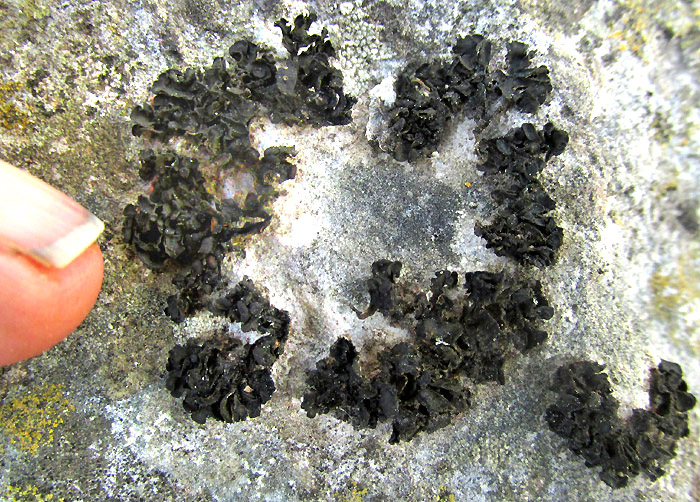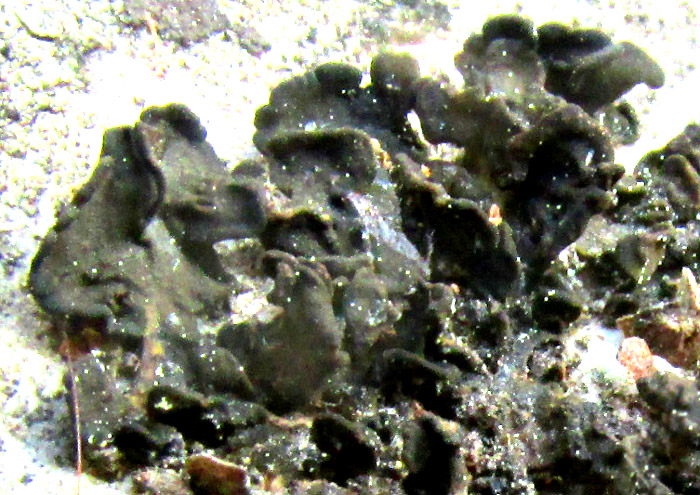Excerpts from Jim Conrad's
Naturalist Newsletter
Entry from field notes dated May 7, 2023, atop hill forested with pines and oaks about 1km east of Curva de la Doctorcilla, on unnamed road connecting Hwy120 and El Doctor; limestone bedrock; elevation ±2650m (8700 ft); Eastern Sierra Madre mountains of east-central Querétaro state, MÉXICO, (N20.88°, W99.62°)
BLACK ROCK LICORICE LICHEN, MAYBE

The above lichen, at home on a watermelon-size limestone rock projecting from the forest floor, drew attention because it formed a black circle. I guess that the colony began as a tuft in the center, then grew outward in all directions, over time the older, center parts dying back while younger more robust parts continued spreading outwards. The finger provides not only scale, but proof that this isn't a black-and-white image.

At first the white specks covering the lichen's black thalli seemed to be sand grains, but later when identical specks consistently appeared on pictures of other individuals of this species, they seemed more likely to be white-topped isidia. Isidia are projections from a lichen's thallus surface which as they wear away form dust-like particles comprising cells of the photosynthesizing algae or cyanobacterium. If the particles land in a suitable environment, they can develop into a new, asexually produced lichen. Possibly on our lichen, when isidia tops wear off, white fungal hyphae are exposed.
With such an obscure but distinctive lichen, at least for non-experts, the best way to begin the identification process is with an Internet image search on keywords such as "lichen black foliose." That approach quickly summoned pictures similar to, or identical, to ours.
Those pictures overwhelmingly showed species belonging in the family Lichinaceae, with no common name. The family mostly is observed in the northern temperate zone, which our high-elevation tropical location approximates.
An important feature of the Lichinaceae is that the photosynthesizing species partnering with the lichen's fungal element is not some species of green alga, which is usually the case, but rather a cyanobacterium. Often we think of aquatic algae as providing most of the world's oxygen, but as reported in the 2020 study by Vincenzo Mascoli and others entitled "Far-red absorption and light-use efficiency trade-offs in chlorophyll f photosynthesis," cyanobacteria are mainly responsible for the oxygenation of the Earth's atmosphere. A feature of their photosynthesis is that they use light wavelengths that algae don't. Our lichen's rock was on the shady side of a hill on the floor of a shady forest. It was so black because it used so efficiently the light that fell on it.
An image search of species belonging to the Lichinaceae turned up many photos of black, scaly lichens in several genera. There were roundish, flat-topped ones, fruticose, foliose, scaly squamulose and in-between types. Once the eye refined its search to our lichen's exact growth habit, thallus thickness manner of forming lobes, the black's mattness, and other gestaltic considerations, the best match was LICHINELLA NIGRITELLA. Often that's called the Black Rock Licorice Lichen.
Features distinguishing this species include the presence of white-topped isidia, thallus lobes bearing several sub-lobes and beginnings of lobes, the matte covering, and the lichen's occurrence on limestone rock, not a silicon-rich rock like granite or rhyolite.
Still, it's a bit awkward to identify our lichen as Lichinella nigritella because, as GBIF's Lichinella nigritella map of recorded observations reveals, that species is documented from Europe and much of North America but extends into Mexico only in the hot, dry northwestern and north-central parts. We're hundreds of kilometers from the nearest documented occurrence. A few other Lichinaceae species have been found in our area, but they look different.
In plant taxonomy, when such a species is said to exhibit such a large distribution area, to occupy habitats from southern Alaska's cooler, moister coastal region, to Baja California's hot deserts, and possibly into our central Mexican cool, high elevations, one suspects that more than one taxa are being lumped under one name.
That may be the case here, since members of the family and the genus Lichinella haven't been comprehensively studied in Mexico. Matthias Schultz in his 2005 article "An Overview of Lichinella in the Southwestern United States and Northwestern Mexico, and the New Species Lichinella granulosa," writes that "... much more data are needed to evaluate the contradictory concepts of genus delimitation and to explain recent distribution patterns." On the positive side, Schultz further describes Lichinella nigritella as colonizing "... steep, shaded rock surfaces," just where this one was found.
LichenPortal.Org's Lichinella nigritella page describes the species as "... the most common of the fruticose-foliose members of the genus." Beyond that, it's good to see experts recognizing that sometimes it's hard to neatly assign particular lichens to the usual categories, that species like this one can be in-between -- fruticose-foliose.